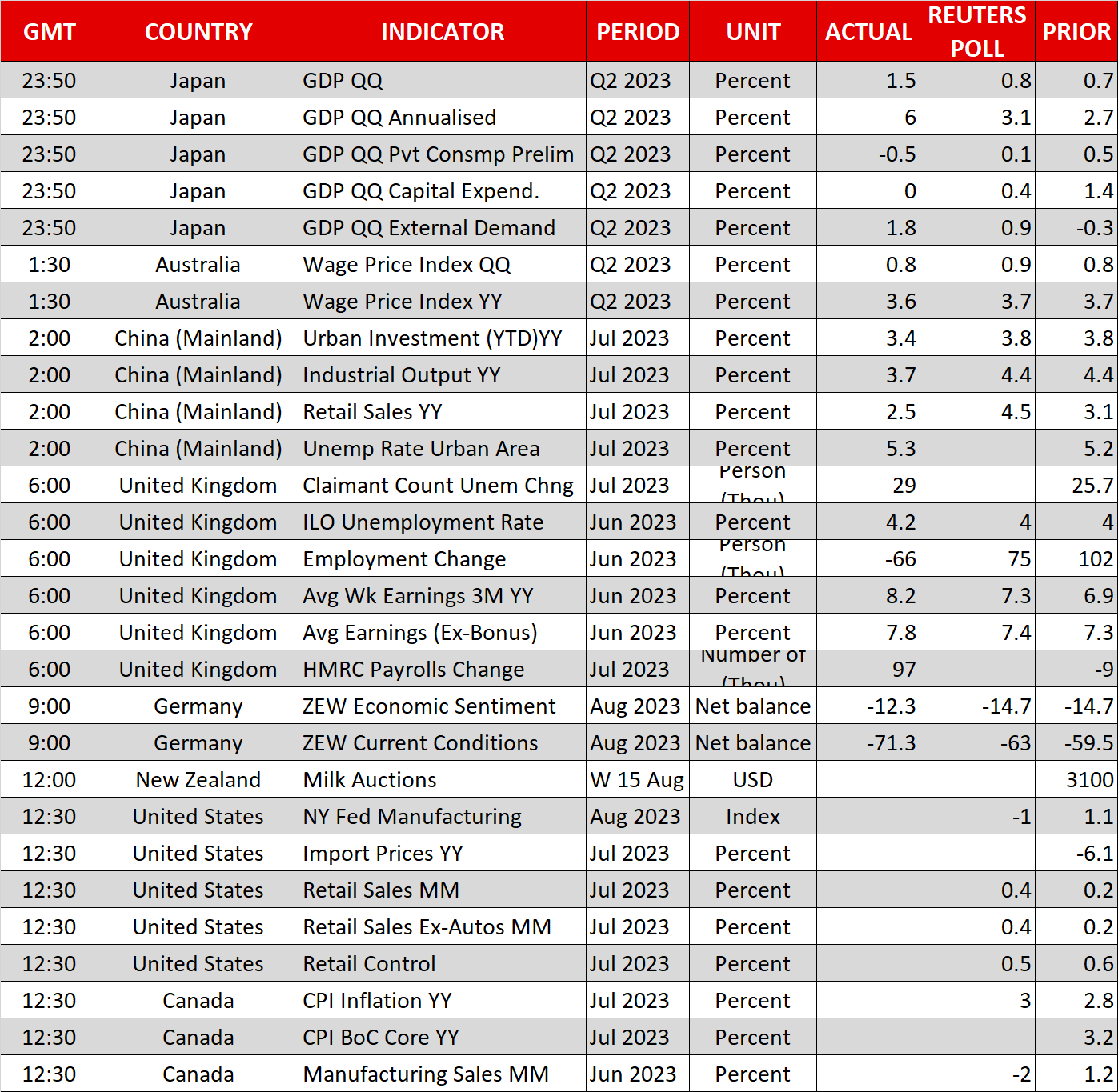- China unexpectedly cuts key lending rate as weak data keeps pouring in, yuan skids
- Japanese growth surges in Q2 but yen hits fresh low, sparking intervention fears
- US retail sales eyed as tech stocks rally despite soaring yields

Yuan slumps after rate cut as China concerns mount
China’s central bank announced a surprise rate cut on Tuesday, lowering its one-year medium-term lending facility by 15 basis points to 2.50%. The seven-day reverse repurchase rate was also cut, but by a slightly smaller increment of 10 bps. The PBOC’s move was in swift response to yet another set of dire economic figures out of China today as the slowdown only seems to be deepening.
Industrial production and retail sales both missed expectations in July, rising by 3.7% and 2.5% y/y, respectively. Fixed asset investment also slowed more than anticipated as property investment declined for a 17th straight month.
The data underscores the growing challenges for authorities to kick-start a stuttering economy amid signs of worsening financial stress that is expanding beyond the property sector. Today’s rate cut will likely go only a small way in alleviating the pressure on businesses but the prospect of further reductions in lending rates pushed the yuan to fresh lows against the US dollar, breaching the 7.30 level for the first time since November 2022.
However, shares in Hong Kong and mainland China pared some of their earlier losses after a rebound in Country Garden stocks on hopes that the property developer might be able to avoid a default after delaying a payment on its onshore bonds yesterday.
No respite for the aussie, rouble plunges
The Australian dollar, which is often traded as a liquid proxy for the Chinese economy, remained under pressure however, edging back towards yesterday’s lows against its US counterpart. Aside from the worsening outlook in China, domestic monetary policy is also weighing on the aussie. The Reserve Bank of Australia gave its clearest indication yet that the cash rate has peaked in the latest meeting minutes that were published today.
The Russian rouble has also been on the slide lately, breaking past the 100 per dollar level on Monday for the first time since the onset of the Ukraine conflict. An emergency rate hike of 350 bps by Russia’s central bank temporarily lifted the rouble on Tuesday but it is already struggling to hold onto its gains.
Yen flirts with intervention zone, pound up on wage data
The yen on the other hand is treading water as traders are wary of a possible intervention by Japanese authorities as the dollar heads towards 146 yen. Japan’s Finance Minister Shunichi Suzuki warned today against excessive currency moves but the fact that he also reiterated that the government is not targeting absolute currency levels suggests an intervention is not imminent.
GDP data released earlier in Asian trading showed the Japanese economy expanded by an impressive 6.0% annualized rate in the second quarter, almost double the expectations of 3.1% growth. Nevertheless, growth was driven entirely by soaring exports and declining imports, while consumption fell, which does not bode well for the domestically driven demand that the Bank of Japan wants to see.
That explains why the yen is somewhat mixed today, caught between speculative trades and safe haven flows.
The pound was having another shot at reclaiming the $1.27 level on the back of much stronger-than-expected wage growth numbers out of the UK on Tuesday. The data wasn’t all positive, as there was a surprise drop in employment in the three months to June, but with the wage-price spiral showing no sign of easing, the Bank of England will be inclined to continue hiking rates.
Moreover, CPI figures are due tomorrow, hence the cautious response in sterling.
Stocks shrug off higher yields but gold flounders
In the meantime, the focus is on US retail sales numbers to be released at 12:30 GMT as investors bet on a soft landing for the US economy. Given the high level of conviction in the markets that the Fed will stay on pause for the rest of the year, there is a risk that better-than-expected prints could push Treasury yields even higher, hurting Wall Street.
The yield on 10-year Treasury notes continued to climb today and is approaching its November 2022 highs. This latest rally in yields has boosted the dollar while battering gold, which is currently trading near seven-week lows and is dangerously close to slipping below $1900/oz.
However, equities have remained relatively resilient and investors are once again on the hunt for buy-the-dip opportunities. The prime example of this is Nvidia (NASDAQ:NVDA), whose stock surged by 7.1% yesterday after an analyst upgrade from Morgan Stanley (NYSE:MS) amid predictions of soaring demand for AI chips. The rally helped the S&P 500 and Nasdaq Composite gain 0.6% and 1.1% respectively, although retailers will now likely come to the fore as they report their earnings over the next few days.
